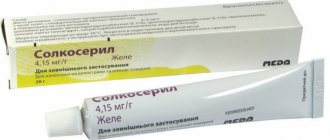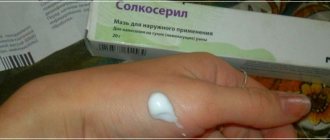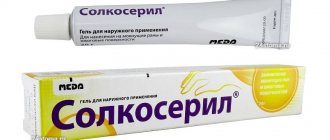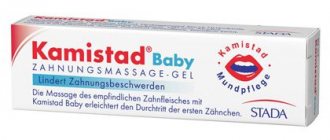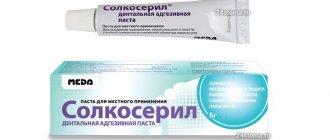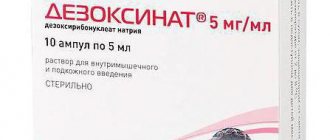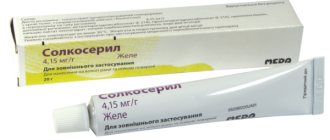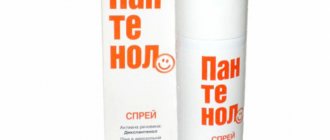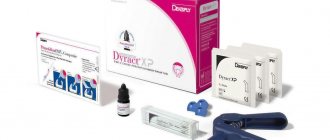The uniqueness of the composition of solcoseryl
The ointment has a uniform, greasy texture; the color can vary from deep white to yellow, with a characteristic odor of broth and petroleum jelly.
The active components of solcoseryl include deproteinized (removal of proteins) hemoderivat from the blood of 3-month-old calves at a concentration of 2.07 mg/g. Auxiliary components are represented by methyl parahydroxybenzoate and propyl parahydroxybenzoate (preservatives), palmitic alcohol (emulsifier), white petrolatum (ointment base), water for injection (dissolution of dry dialysate).
An analogue of the drug is Actovegin ointment. These drugs appeared on the pharmaceutical market almost simultaneously and differ only in the manufacturer and price.
The main active ingredient of solcoseryl is a deproteinized hemoderivat, which is obtained by dialysis and subsequent ultrafiltration. During the production process, high molecular weight proteins are removed (deproteinization). This is a complex compound that includes natural low-molecular substances with a molecular weight of up to 5000 Da.
Such a unique composition cannot be reproduced in laboratory conditions. Basically, these are electrolytes, amino acids, nucleotides, nucleosides. The effectiveness of only some of these substances has been described and proven from a pharmacological point of view. However, in vitro tests have proven the effectiveness of solcoseryl in the treatment of damaged tissues and wound surfaces.
Composition of the drug and form of manufacture
This medicine is sold in the form of aluminum tubes of 5 grams each, which are packaged in separate cardboard boxes.
The drug itself is a homogeneous mass that has a light orange color and has a rich mint smell. The homogeneity of solcoseryl gel allows it to be evenly applied over the surface of the wound. The composition of solcoseryl ointment includes the following elements:
- dialysate from the blood of a young calf in which there are no proteins.
Antigens are extracted from the blood using special chemical and biological treatment. This element is the main active substance of the drug;
- relieve pain (polidocanol);
- peppermint oil/menthol (auxiliary elements);
- components taken as the basis for solcoseryl ointment (pectin, liquid paraffin, gelatin, etc.);
- preservative substances (parahydroxybenzoate, pilparahydroxybenzoate);
Pharmacological action of the ointment
The pharmacological properties of the drug have not been fully studied. However, during the studies it was proven that solcoseryl has the following properties:
- in case of oxygen deficiency, its delivery to damaged cells is ensured;
- glucose transfer in metabolic disorders;
- is a catalyst for the formation of intracellular ATP;
- ensures the storage of energy in mitochondria generated during the transformation of nutrients;
- supports cells during nutritional deficiencies by supplying high-energy phosphates;
- prevents or prevents atypical changes with minor cell damage;
- “launches” the process of natural restoration of cells and tissues;
- activates the proliferation (division and formation) of fibroblasts that form the framework of connective fibers, and the formation of collagen filaments in the walls of blood vessels.
The ointment is widely used in cosmetology, gynecology, ophthalmology, and dentistry.
Main indications for use of the product
Ointment with solcoseryl is recommended for:
- minor skin damage in the form of abrasions;
- burns (except chemical) 1-2nd degree, which occur without the formation of exudate;
- frostbite of the 1st-2nd degree in the absence of wound weeping;
- psoriasis;
- to eliminate dry calluses and corns;
- to prevent the formation of scars after laser removal of warts or moles;
- atopic and seborrheic dermatitis;
- “sticking” in the corners of the mouth;
- drying of the nasal mucosa;
- in the treatment of wounds that heal poorly, including trophic ulcers and bedsores, after removal of dead tissue.
As a rule, a gel with solcoseryl is first applied to treat the wound surface with the separation of exudate. After the first signs of wound granulation appear, therapy is continued with the drug in the form of an ointment.
Differences between the ointment form of solcoseryl and the gel form
Pharmacies offer 2 forms of the drug intended for external local use. How do they differ and is it necessary to pay attention to such nuances?
The main differences between the forms are due to the excipients. Thus, solcoseryl gel does not contain fatty bases, which is why it is quickly washed off with warm water and removed from the surface of the skin. Due to this, it is the gel form that stimulates the formation of granulation tissue and the elimination of wound exudate.
When the wound dries out and signs of granulation appear, it would be more appropriate to use ointment. The fatty base of the drug forms a protective film on the surface of the wound, so the healing process is noticeably faster. In addition, solcoseryl ointment softens the surface of the wound, thereby avoiding the appearance of scars and other skin defects.
How to use the ointment
Instructions for use of solcoseryl include the following recommendations:
- the ointment is applied only topically directly to the wound, covering those areas where the healing process has begun;
- the wound surface is pre-cleaned with disinfectant solutions, since the ointment does not contain antibacterial components;
- in case of purulent infection, cleanse from exudate and dead tissue;
- ointment is prescribed for the treatment of injuries with clear signs of healing;
- apply solcoseryl to the surface of the wound in the morning and evening, apply a bandage if necessary;
- Treatment should be continued until the wound is completely scarred.
The use of solcoseryl is determined by the type of pathology. Thus, for chronic trophic ulcers, it is recommended to treat the inner surface with solcoseryl gel, and the outer edges of the wound with ointment 2 times a day for 3 weeks. For diabetic feet without exudate, the ointment is applied twice a day for 2 months.
In proctology, solcoseryl ointment has only positive reviews from patients. This is due to the fact that the drug promotes rapid tissue healing and stimulates blood supply in damaged vessels. However, the ointment can be used only for external forms of hemorrhoids, which are not accompanied by the formation of anal fissures (in this case, it is more appropriate to prescribe solcoseryl gel). The drug is applied to hemorrhoids 4-5 times a day for a week.
The nuances of using the ointment:
- The drug should not be used by pregnant women or during lactation, since appropriate clinical trials have not been conducted;
- if pain appears in the wound area, redness of the skin around the injury, exudate, or elevated body temperature, you should consult your doctor;
- If there are no signs of wound healing within 2-3 weeks of use, you should immediately consult a doctor, as this may indicate a benign or malignant wound process.
Solcoseryl dental adhesive paste 5g
Description
Light beige, granular, easily distributed homogeneous mass with the smell of peppermint.
Release form
5 g in aluminum tubes. The tube, along with instructions for use, is placed in a cardboard box.
special instructions
You should not put Solcoseryl dental adhesive paste into the wound cavity formed as a result of the removal of molars, wisdom teeth, as well as apicotomy (resection of the apex of the tooth), if the edges of the tooth socket are tightened with subsequent sutures. Solcoseryl dental adhesive paste does not contain anti-infective components. In case of acute infection of the affected area of the oral mucosa, which is subject to treatment with this drug, it is necessary to carry out preliminary medical treatment/treatment of the affected area aimed at eliminating the symptoms of inflammation.
pharmachologic effect
Solcoseryl is a deproteinized hemodialysate that contains a significant amount of low-molecular components of cells and blood serum of calves (dialysis/ultrafiltration, maximum molecular weight 5000 Da), the chemical and pharmacological properties of which are only partially described to date. A study of the drug on various cell and tissue cultures, organs, as well as animals showed that Solcoseryl: maintains and/or restores aerobic energy metabolism, as well as oxidative phosphorylation processes in cells deprived of sufficient nutrients, thereby maintaining and/or restoring supply of high-energy phosphates, increases oxygen uptake (in vitro), as well as glucose transport in hypoxic and metabolically depleted tissues and cells, improves repair and regeneration processes in damaged tissues and/or tissues deprived of sufficient nutrients, prevents and/or reduces secondary degeneration and pathological changes in reversibly damaged cellular systems, enhances collagen synthesis in in vitro models, and also stimulates cell proliferation and migration in vitro. Consequently, Solcoseryl dental adhesive paste protects tissues prone to hypoxia and/or substrate depletion. It stimulates the restoration of functions in reversibly damaged tissue, and also accelerates the healing of lesions and improves the quality of this process. Macrogol-9-lauryl ether (Polidocanol 600), a topical anesthetic, reversibly blocks peripheral nerve endings. Due to its high wetting ability, the analgesic effect occurs within 1-3 minutes after application. Due to the adhesive ability of the paste, this effect can last from 1 to 5 hours, depending on the location of the lesion and salivation. After swelling under the influence of saliva and wound secretions, the paste base, consisting of pectin, gelatin, sodium carboxymethylcellulose, liquid paraffin and polyethylene, forms an adhesive and elastic protective film on the wound.
Indications for use
Solcoseryl dental adhesive paste is used for local acceleration of healing, pain relief and protection of the wound surface in the following diseases and conditions: Treatment of painful and inflammatory processes of the oral mucosa, gums and lips (aphthae, labial herpes, gingivitis, periodontitis, stomatitis) Treatment of lesions caused by pressure of dentures on tissue (bedsores) Treatment of complications associated with the appearance of wisdom teeth Treatment of wounds after removal of tartar, curettage, periodontal surgery, tooth extraction and installation of immediate dentures Alveolitis.
Directions for use and doses
The drug is intended for local use in the oral mucosa. The affected surface of the mucous membrane must first be dried with a cotton or gauze swab. Apply a strip of paste about 0.5 cm long, without rubbing, onto the mucous membrane in a thin layer using a finger or a cotton swab, and then lightly moisten the applied paste with water. The procedure is repeated 3-5 times a day after meals and before bedtime. Treatment is carried out until symptoms disappear. Solcoseryl dental adhesive paste forms a protective healing layer on the affected area of the oral mucosa and protects it from mechanical and chemical damage for 3-5 hours. When applying the paste to undried mucous membranes, the duration of the therapeutic effect may be reduced. When treating bedsores from removable dentures, apply the paste to a dry denture and moisten with water. The recommended course dose of the drug is 1 tube (5 g). Special categories of patients Children The effectiveness and safety of the drug in children aged 2-5 years have not been sufficiently studied. There are no restrictions regarding the use of the drug in children over 2 years of age. There are no restrictions regarding the use of the drug in elderly patients.
Use during pregnancy and lactation
Animal studies have shown no risk to the fetus, but there have been no controlled studies in pregnant women. Caution should be exercised when used during pregnancy. There are no objections to the use of Solcoseryl dental adhesive paste during lactation.
Interaction with other drugs
To date, there have been no cases of interaction between Solcoseryl dental adhesive paste and other drugs. When simultaneously prescribing Solcoseryl dental adhesive paste and other drugs in the form of rinses, the paste should be applied after using these drugs.
Contraindications
individual sensitivity to any of the components of the drug (to preservatives - esters of parahydroxybenzoic acid (E216 and E218)), including free parahydroxybenzoic acid (E 210), the presence of a residual amount of which is due to the peculiarities of the technological process during the production of the drug. Infants and children under two years of age: Peppermint oil and levomenthol may cause spasm of the larynx, leading to serious breathing problems.
Compound
per 1 g Active ingredients: Solcoseryl (deproteinized dialysate from the blood of dairy calves), in terms of dry matter - 2.125 mg; polidocanol - 10,000 mg. Excipients: sodium carboxymethylcellulose, methyl parahydroxybenzoate (E 218), propyl parahydroxybenzoate (E 216), peppermint oil, menthol. Paste base: sodium carboxymethylcellulose, gelatin, pectin, polyethylene, liquid paraffin.
Overdose
There is no information on the effects of an overdose of the drug.
Side effect
change in taste sensations: allergic reactions (local swelling) are possible, if they occur, you must stop using the drug and consult a doctor. In rare cases (less than 0.01%), allergic reactions, in particular shortness of breath, may develop. In such cases, you should stop using the drug. May cause laryngospasm in infants and children under 2 years of age.
Storage conditions
Store at a temperature not exceeding 25°C. Keep out of the reach of children! The granular-dry consistency of the paste ensures its optimal adhesive properties and is not a sign of deterioration in the quality of the drug. When opening the tube, oil may be released, which is also not a sign of deterioration in the quality of the drug.
Buy Solcoseryl dental adhesive paste 5g in a pharmacy
Price for Solcoseryl dental adhesive paste 5g
Instructions for use for Solcoseryl dental adhesive paste 5g
Possible side effects and contraindications
Very rarely, urticaria, itching, redness, and marginal dermatitis appear at the site of application of solcoseryl. If such allergic reactions occur, it is recommended to stop using the ointment and consult a doctor to change the drug.
Solcoseryl is contraindicated in case of hypersensitivity to the components of the ointment. It is also recommended to use it with caution in patients prone to allergies.
Solcoseryl in cosmetology: effective fight against wrinkles
Women appreciated the effect of the drug on the condition of the skin, although the instructions do not contain instructions for using solcoseryl for the face. Based on it, recipes for many masks have been created that effectively even out skin tone, promote the healing of microtraumas, and solcoseryl also helps get rid of wrinkles.
Cosmetologists explain the effectiveness of solcoseryl as a cosmetic product by the pharmacological action of the drug. Stimulating metabolism in cells, collagen synthesis and activating tissue repair make it possible to use solcoseryl to combat wrinkles.
However, there are no studies that would confirm its effectiveness, which does not prevent the drug from being used in beauty salons and at home as part of a variety of face masks. Women consider the safety and low cost of procedures to be the indisputable advantage of cosmetics with the addition of solcoseryl.
Cosmetologists claim that solcoseryl ointment moisturizes and nourishes the skin, promotes the healing of small cracks and saturates cells with oxygen. The ointment is mixed with nourishing cream in a 1:1 ratio and the mixture is applied to the facial skin twice a week at night. Solcoseryl can be used undiluted as a face mask. The ointment is applied to the skin for 1.5 hours, after which it is washed off with warm water.
The ointment is especially effective as a lip balm. To do this, solcoseryl is mixed with your favorite balm and applied to the skin of the lips. This product helps to quickly restore damaged skin.
Indications for use of solcoseryl ointment (instructions for use)
The paste will be effective for use by people of any age group.
The practical use of solcoseryl ointment should be carried out when the following diseases are identified:
- gingivitis and stomatitis;
- pemphigus and alveolitis;
- periodontal disease.
Mechanical damage to the oral cavity can also result from the use of solcoseryl gel:
- deformations of the soft tissues of the gums, wounds (cracks) of the lips;
- jaw fractures;
- injuries resulting from operations in the oral cavity;
- bedsores under fillings and dentures.
Contraindications to the use of the drug are very difficult to predict, since any of the elements included in its composition can cause an allergic reaction.
